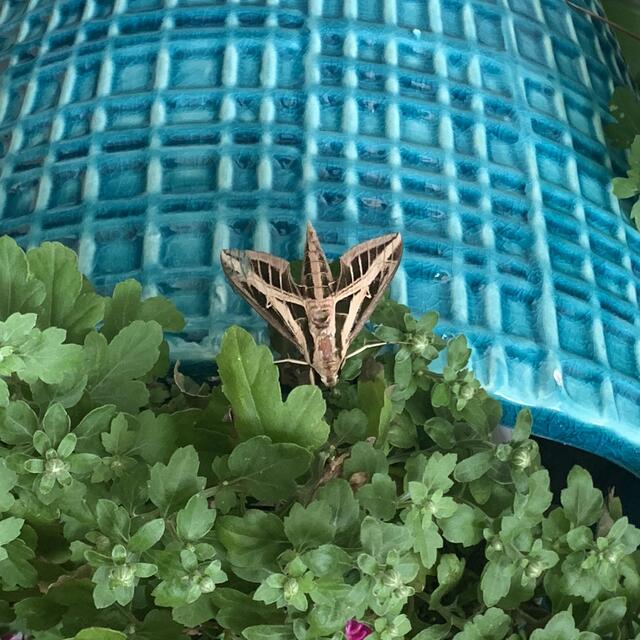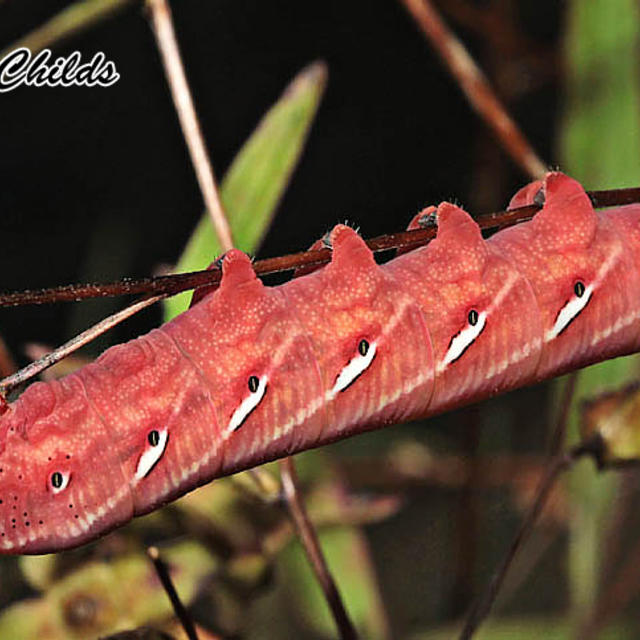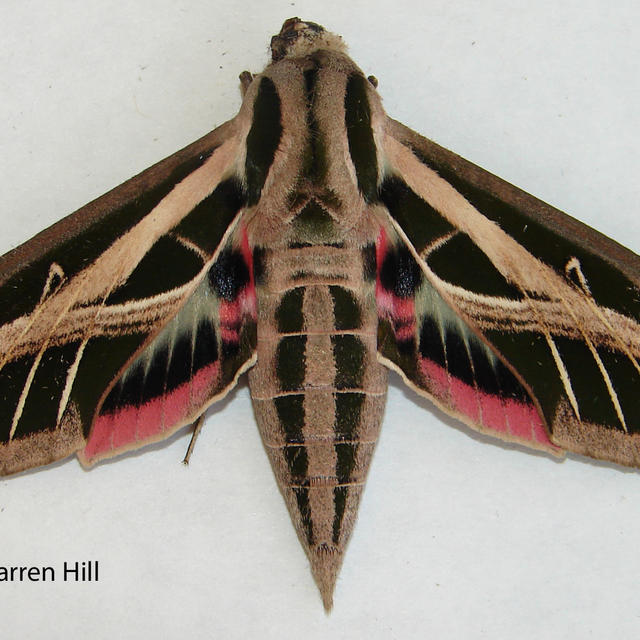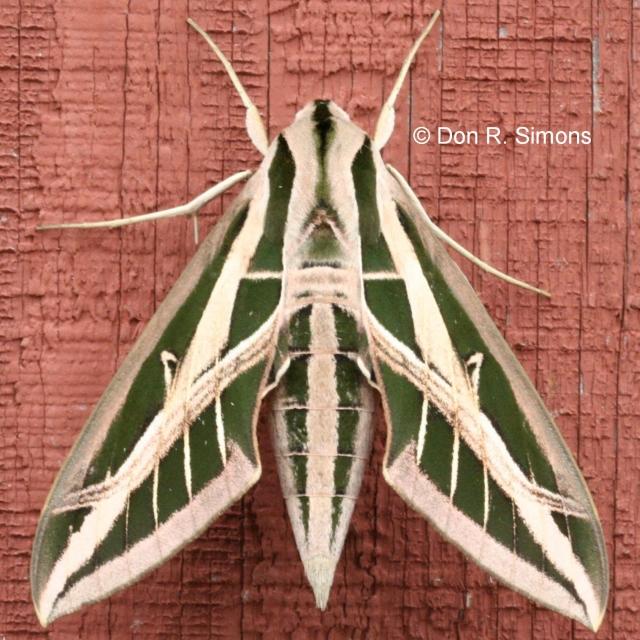Banded sphinx
Eumorpha fasciatus (Sulzer, 1776)
Family: Sphingidae
Subfamily: Macroglossinae
Identification: Upperside is dark pinkish brown. Forewing has a lighter brown band along the costa, and sharp pinkish white bands and streaks. Hindwing has a pink patch on the inner margin and pink along the outer margin.
Wing Span: 3 7/16 - 3 13/16 inches (8.7 - 9.6 cm).
Life History: Adults begin feeding at dark. Caterpillars pupate in shallow chambers in the soil.
Flight: . Several flights in Florida throughout the year, several flights in Louisiana from April-November, two flights in coastal South Carolina from May-July and August-October, one brood northward from August-November.
Caterpillar Hosts: Primrose-willow and other plants in the evening primrose family (Onagraceae).
Adult Food: Flower nectar.
Habitat: Tropical, subtropical, and austral lowlands.
Range: Northern Argentina north through Central America and Mexico to southern California and southern Arizona; east to Texas, Mississippi, Florida, and South Carolina. Strays north to Missouri, Michigan, Pennsylvania, New York, and Nova Scotia.
Conservation: Not usually required.
NCGR: G5 - Demonstrably secure globally, though it may be quite rare in parts of its range, especially at the periphery.
Management Needs: None reported.
Comments: NULL
Alternate Scientific Names:
Eumorpha fasciata
BAMONA Shop
Please donate!
We depend on donations to keep Butterflies and Moths of North America freely available. We want to express our gratitude to all who showed their support by making a contribution this year. You can donate to support this project at any time.
Advertise with us!
Do you have a product or service that you think would interest BAMONA users? If you would like to advertise on this website, contact us by email, or use the contact form and select the "Advertising" category.
Verified Sightings
Displaying 1 - 24 of 568 verified sightings

Observation date: Sep 09, 2024
Submitted by: Sejohnson10204
Region: Newton County, Georgia, United States
Verified by: jwileyrains
Verified date: Jul 05, 2025

Observation date: Oct 08, 2024
Submitted by: @SherryKaraoke
Region: Hancock County, Mississippi, United States
Verified by: stomlins701
Verified date: Jan 24, 2025

Observation date: Nov 12, 2024
Submitted by: Brittken911
Region: Sarasota County, Florida, United States
Verified by: curtis.lehman
Verified date: Nov 13, 2024

Observation date: Oct 07, 2024
Submitted by: Wschortinghouse
Region: Marion County, Florida, United States
Verified by: curtis.lehman
Verified date: Oct 12, 2024

Observation date: Sep 26, 2024
Submitted by: Aspenbooboo41
Region: Lehigh County, Pennsylvania, United States
Verified by: curtis.lehman
Verified date: Oct 04, 2024

Observation date: Sep 05, 2024
Submitted by: Cindyinbna
Region: Davidson County, Tennessee, United States
Verified by: rogerdowner
Verified date: Sep 06, 2024

Observation date: Jul 29, 2024
Submitted by: Mandagraph
Region: Harris County, Texas, United States
Verified by: stomlins701
Verified date: Sep 05, 2024

Observation date: Jul 29, 2024
Submitted by: gemini_jen
Region: Oklahoma County, Oklahoma, United States
Verified by: stomlins701
Verified date: Sep 05, 2024

Observation date: Aug 30, 2024
Submitted by: Cheri Pierce
Region: Lake County, Florida, United States
Verified by: curtis.lehman
Verified date: Aug 30, 2024

Observation date: Aug 28, 2024
Submitted by: Cybersunset
Region: Polk County, Florida, United States
Verified by: curtis.lehman
Verified date: Aug 29, 2024

Observation date: Aug 24, 2024
Submitted by: GracefulKlutz
Region: Osceola County, Florida, United States
Verified by: curtis.lehman
Verified date: Aug 24, 2024

Observation date: Aug 08, 2024
Submitted by: NancyLK
Region: Guilford County, North Carolina, United States
Verified by: rogerdowner
Verified date: Aug 08, 2024

Observation date: Aug 06, 2024
Submitted by: L8EBUGS
Region: Charleston County, South Carolina, United States
Verified by: Dennis Forsythe
Verified date: Aug 07, 2024

Observation date: Jul 24, 2024
Submitted by: Kiki72
Region: Wake County, North Carolina, United States
Verified by: rogerdowner
Verified date: Jul 24, 2024

Observation date: Jul 10, 2024
Submitted by: ARomero84
Region: Berkeley County, South Carolina, United States
Verified by: Dennis Forsythe
Verified date: Jul 11, 2024

Observation date: Jul 10, 2024
Submitted by: Npolk21580
Region: Harris County, Texas, United States
Verified by: stomlins701
Verified date: Jul 11, 2024

Observation date: May 26, 2024
Submitted by: miloscoggins
Region: Collin County, Texas, United States
Verified by: stomlins701
Verified date: Jul 02, 2024

Observation date: May 17, 2024
Submitted by: ArtistEclectic
Region: Talladega County, Alabama, United States
Verified by: stomlins701
Verified date: Jul 02, 2024

Observation date: Jul 13, 2017
Submitted by: BYoung1441
Region: The Bahamas
Verified by: curtis.lehman
Verified date: Apr 14, 2024

Observation date: Oct 26, 2023
Submitted by: kriscassi
Region: Denton County, Texas, United States
Verified by: stomlins701
Verified date: Oct 30, 2023

Observation date: Oct 12, 2023
Submitted by: Jdrevenkar
Region: Collier County, Florida, United States
Verified by: curtis.lehman
Verified date: Oct 12, 2023

Observation date: Sep 29, 2023
Submitted by: altoonamothlady
Region: Lake County, Florida, United States
Verified by: curtis.lehman
Verified date: Sep 30, 2023

Observation date: Sep 23, 2023
Submitted by: Livpaula
Region: Forsyth County, North Carolina, United States
Verified by: rogerdowner
Verified date: Sep 23, 2023

Observation date: Sep 12, 2023
Submitted by: Brendavent
Region: Collier County, Florida, United States
Verified by: curtis.lehman
Verified date: Sep 12, 2023
- 1 of 24
- next ›












